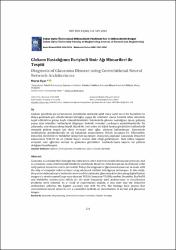| dc.contributor.author | Uçar, Murat | |
| dc.date.accessioned | 2022-01-13T10:40:37Z | |
| dc.date.available | 2022-01-13T10:40:37Z | |
| dc.date.issued | 2021 | en_US |
| dc.identifier.citation | Uçar, M. (2021). Glokom Hastalığının Evrişimli Sinir Ağı Mimarileri ile
Tespiti. Dokuz Eylül Üniversitesi Mühendislik Fakültesi Fen ve Mühendislik Dergisi, 23(68), 521 - 529. https://doi.org/10.21205/deufmd.2021236815 | en_US |
| dc.identifier.uri | https://hdl.handle.net/20.500.12508/2123 | |
| dc.identifier.uri | https://doi.org/10.21205/deufmd.2021236815 | |
| dc.identifier.uri | https://dergipark.org.tr/tr/pub/deumffmd/issue/62048/758948 | |
| dc.description.abstract | Glokom, genellikle göz içi basıncının yükselmesi nedeniyle optik sinire zarar veren bir hastalıktır ve
dünya genelinde geri döndürülemez körlüğün yaygın bir sebebidir. Ancak hastalık erken dönemde
tespit edilebilirse görme kaybı önlenebilmektedir. Günümüzde glokom hastalığının tanısı, gelişmiş
yapay zeka teknikleri kullanılarak bilgisayar destekli sistemler yardımıyla yapılabilmektedir. Bu
çalışmada, yeni oluşturulmuş büyük ölçekli bir veri setine ait dijital fundus görüntüleri kullanılarak
otomatik glokom tespiti için derin evrişimli sinir ağları yöntemi kullanılmıştır. Literatürde
sınıflandırma problemlerinde en sık kullanılan mimarilerden VGG16, Inception-V3, EfficientNet,
DenseNet, ResNet50 ve MobileNet mimarileri seçilmiştir. Deneysel çalışmalar sonucunda DenseNet
mimarisinin %96.19 ile en yüksek başarı oranını elde ettiği görülmüştür. Elde edilen bulgular
evrişimli sinir ağlarının normal ve glokomlu görüntüleri sınıflandırmada başarılı bir yöntem
olduğunu kanıtlamıştır. | en_US |
| dc.description.abstract | Glaucoma is a disease that damages the optic nerve, often due to increased intraocular pressure, and
is a common cause of irreversible blindness worldwide. However, if the disease can be detected in the
early period, vision loss can be prevented. Today, the diagnosis of glaucoma disease can be made with
the help of computer-aided systems using advanced artificial intelligence techniques. In this study,
deep convolutional neural networks were used for automatic glaucoma detection using digital fundus
images of a newly created large-scale data set. VGG16, Inception-V3, EfficientNet, DenseNet, ResNet50
and MobileNet architectures which are the most frequently used architectures in classification
problems were selected. As a result of experimental studies, it was seen that the DenseNet
architecture achieved the highest accuracy rate with 96.19%. The findings have proven that
convolutional neural networks are a successful methods on classification of normal and glaucoma
images. | en_US |
| dc.language.iso | tur | en_US |
| dc.publisher | Dokuz Eylül Üniversitesi Mühendislik Fakültesi | en_US |
| dc.relation.isversionof | 10.21205/deufmd.2021236815 | en_US |
| dc.rights | info:eu-repo/semantics/openAccess | en_US |
| dc.subject | Glokom | en_US |
| dc.subject | Derin öğrenme | en_US |
| dc.subject | Evrişimli sinir ağları | en_US |
| dc.subject | Transfer öğrenimi | en_US |
| dc.title | Glokom Hastalığının Evrişimli Sinir Ağı Mimarileri ile Tespiti | en_US |
| dc.title.alternative | Diagnosis of Glaucoma Disease using Convolutional Neural Network Architectures | en_US |
| dc.type | article | en_US |
| dc.relation.journal | Dokuz Eylül Üniversitesi Mühendislik Fakültesi Fen ve Mühendislik Dergisi | en_US |
| dc.contributor.department | İşletme ve Yönetim Bilimleri Fakültesi -- Yönetim Bilişim Sistemleri Bölümü | en_US |
| dc.identifier.volume | 23 | en_US |
| dc.identifier.issue | 68 | en_US |
| dc.identifier.startpage | 521 | en_US |
| dc.identifier.endpage | 529 | en_US |
| dc.relation.publicationcategory | Makale - Ulusal Hakemli Dergi - Kurum Öğretim Elemanı | en_US |
| dc.contributor.isteauthor | Uçar, Murat | |
| dc.relation.index | TR-Dizin | en_US |
















